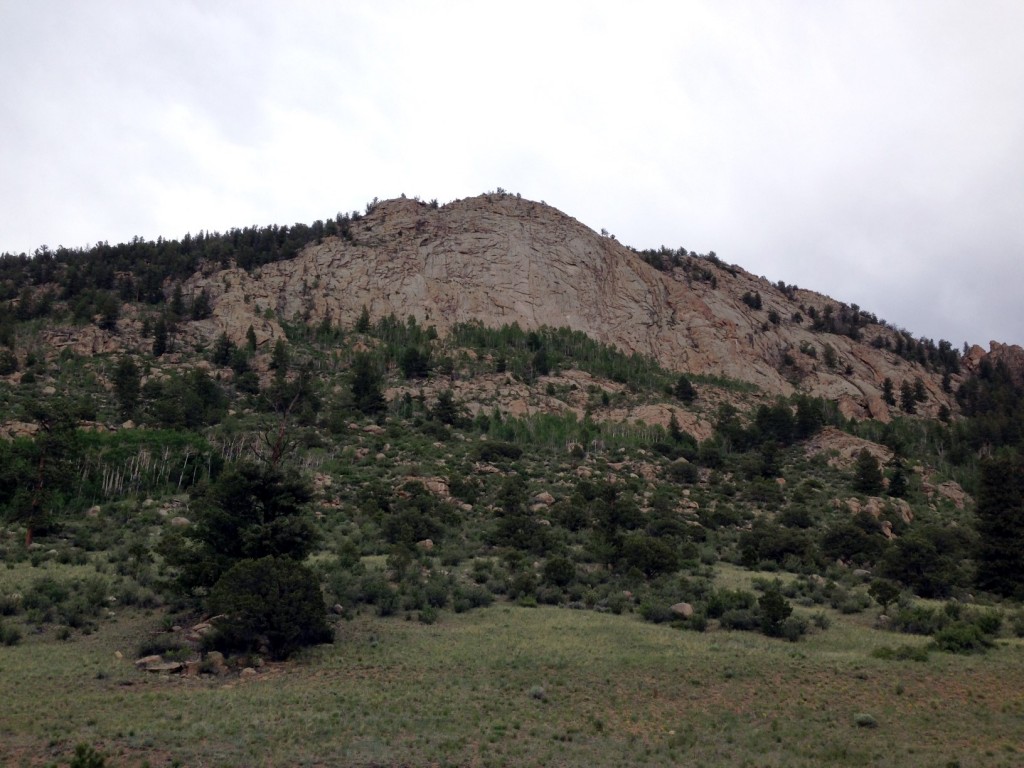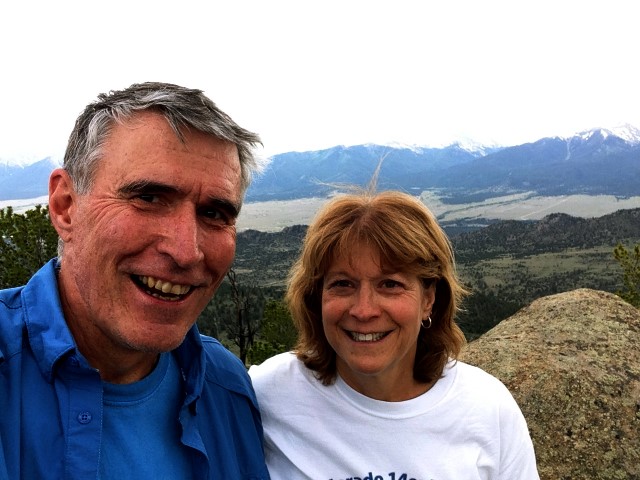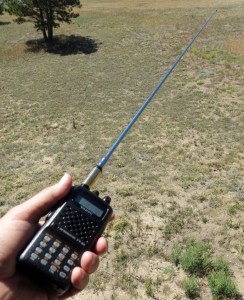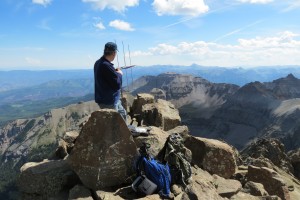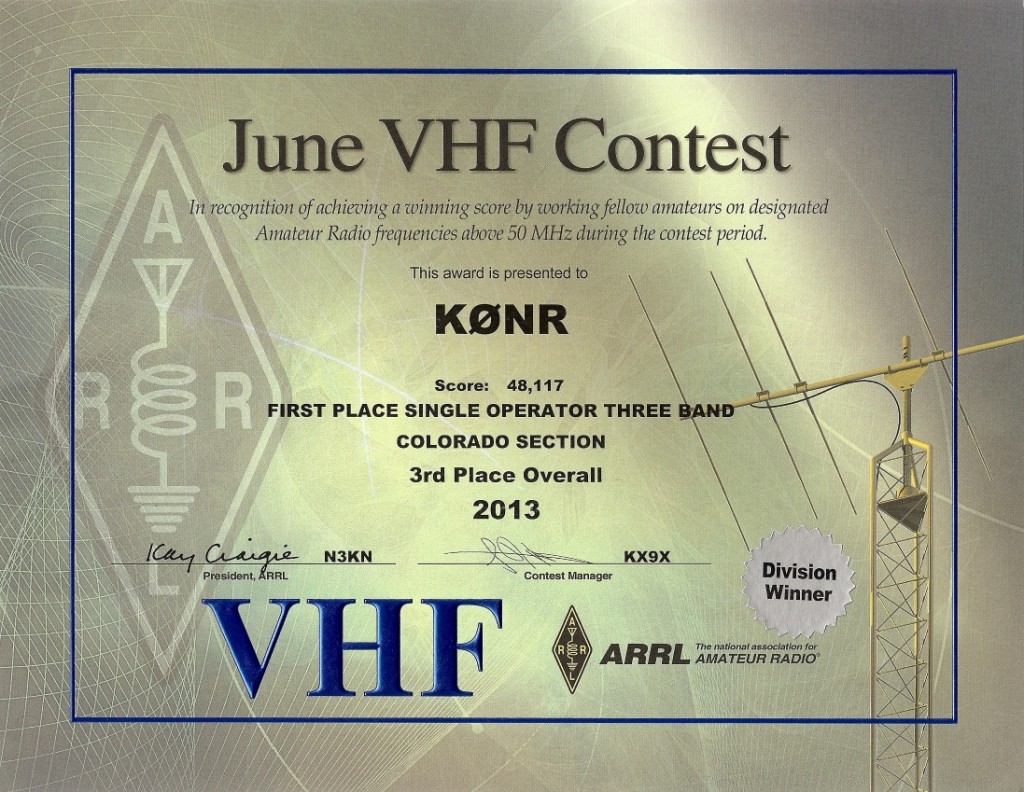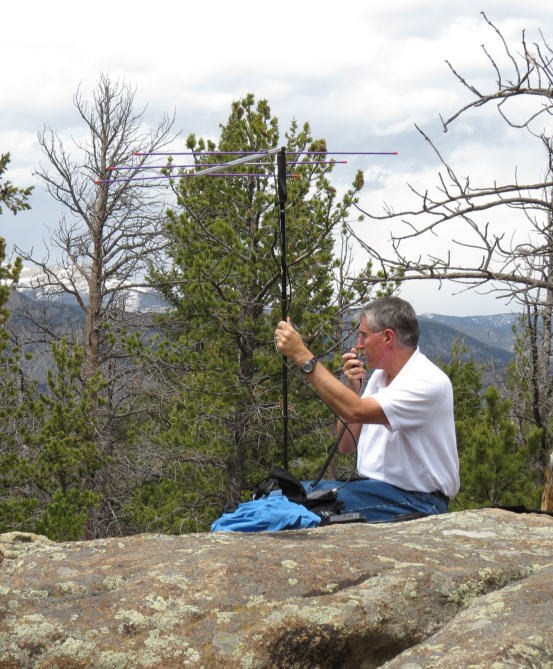Author Archive
 Making Plans for the Colorado 14er Event
Making Plans for the Colorado 14er Event
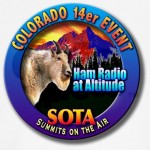 The Colorado 14er Event (Aug 3) is less than a month away so it is time to get ready. This event was born out of the basic observation that many hiking hams were taking along their radios (typically, a VHF/UHF handheld) when they climbed the Colorado 14,000 foot mountains. So we thought “let’s all climb on the same day and see who we can contact.” The typical 2m FM contacts have expanded to other frequencies and modes, including the high frequency bands, with the potential for worldwide propagation. We’ve also embraced the Summits On The Air (SOTA) program, opening up over 1700 summits in Colorado for ham radio activity.
The Colorado 14er Event (Aug 3) is less than a month away so it is time to get ready. This event was born out of the basic observation that many hiking hams were taking along their radios (typically, a VHF/UHF handheld) when they climbed the Colorado 14,000 foot mountains. So we thought “let’s all climb on the same day and see who we can contact.” The typical 2m FM contacts have expanded to other frequencies and modes, including the high frequency bands, with the potential for worldwide propagation. We’ve also embraced the Summits On The Air (SOTA) program, opening up over 1700 summits in Colorado for ham radio activity.
How can you join in the fun? The most active way to participate is to operate from a summit. If you are interested in climbing 14ers, then you may want to operate from one of the 54 14,000 foot mountains. In my opinion, all of the 14ers are strenuous hikes, so be sure to assess your ability and check out the challenge of any summit you attempt. There are a few that you can drive up, Pikes Peak, Mount Evans and Mount Bross (4WD only). Note that a “non-motorized final ascent” is required if you want to qualify as a SOTA activation, which is encouraged. See this web page for some great tips on activating a SOTA peak. If you want to try something less difficult, consider one of the easier SOTA peaks (more than 1700 in Colorado). Everyone can find a SOTA peak that fits their particular hiking ability.
If you can’t get out and operate from a summit, you can still have fun trying to contact the radio hams on the various summits. There will be quite a bit of activity on 2m FM, starting with 147.42 MHz and moving up from there using the standard Colorado band plan. You’ll want to be roughly within “line of sight” to as many peaks as possible for working them on VHF. Many radio operators will be on the HF bands, too. See the recommended frequency list here.
Summits On The Air has some great infrastructure that we can use during the event. The SOTAwatch web site is using for “spotting” SOTA stations so that you know who is on the air. Spotting yourself is encouraged and can be done from many peaks using a mobile phone. SOTA Goat is a great iOS app for making and tracking spots.
Take a look at this posting for some additional SOTA resources. There’s quite a bit of information out there so take advantage of it. Remember, the Colorado 14er Event is based on the fundamental purpose of ham radio: to have fun messing around with radios. But be careful out there, we don’t want anyone to get hurt.
Questions, comments, let me know.
73, Bob K0NR
Disclaimer: Climbing mountains in Colorado can be dangerous. Only you are responsible for your safety. In particular, be very aware of the lightning danger if you are hiking above treeline.
 SOTA Activation: W0C/SP-089 Unnamed Summit
SOTA Activation: W0C/SP-089 Unnamed Summit
With the summer season definitely here, Joyce (K0JJW) and I climbed W0C/SP-089, an unnamed summit east of Buena Vista near Trout Creek Pass, for a Summits On The Air activation. This summit is also referred to by its elevation: 10525. The mountain is quite majestic with a large rock face that rock climbers enjoy climbing.
To reach the summit, we drove a 4WD truck from Trout Creek Pass on Forest Service Road 311, connecting to FS Road 373. Four wheel drive is required for this road due to the steep sections, which may not be passable in muddy conditions. You can also approach from the Buena Vista side, see the San Isabel Forest Service Map. From 373 we took a side road (shown in blue on the map below) that is not always shown on maps. I believe it is marked 373A but I am not sure. We parked the truck at the lat/lon shown.
From there we hiked a non-technical route to the west of the summit, working our way up through the draw shown on the map. There were a few faint game trails here and there but mostly it was some challenging bushwhacking up that draw. The willows and sticker bushes made us glad that we had long pants on. Also, there was quite a bit of downed timber to step over. The route got quite a bit easier once we got to the top of the draw, but still no trail. The elevation gain was only 1100 feet but it felt like a lot more work than that.
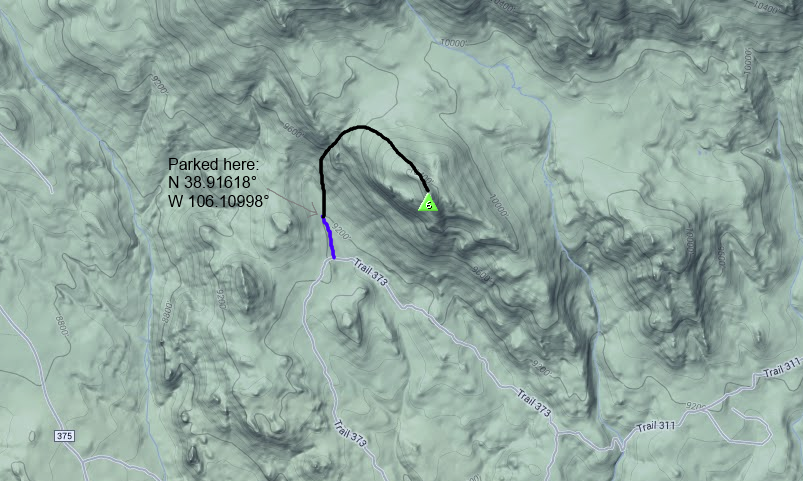 As we neared the summit, I heard Bob (W0BV) calling me on 146.52 MHz. I had put out an email alert to some of the hams in the area so Bob and some others knew I was going to be out climbing. Once I got to the summit, I contacted Bob (W0BV) and quickly had a mini-pileup with several stations calling me. Mark (KF5WCY) visiting from TX gave me a call, followed by Carl (K5UK) near Mount Yale. Then I worked Jim (KD0MRC) in Buena Vista and Larry (KL7GLK) in Leadville. Thanks, guys, for getting on the air and contacting me!
As we neared the summit, I heard Bob (W0BV) calling me on 146.52 MHz. I had put out an email alert to some of the hams in the area so Bob and some others knew I was going to be out climbing. Once I got to the summit, I contacted Bob (W0BV) and quickly had a mini-pileup with several stations calling me. Mark (KF5WCY) visiting from TX gave me a call, followed by Carl (K5UK) near Mount Yale. Then I worked Jim (KD0MRC) in Buena Vista and Larry (KL7GLK) in Leadville. Thanks, guys, for getting on the air and contacting me!
I used my Yaesu FT-60 handheld transceiver and a 1/2-wave vertical antenna for these contacts. While I had my 3-element Yagi antenna with me, I did not bother to set it up.
My spouse and hiking companion Joyce (K0JJW) and I have worked out a standard SOTA activating procedure. As we get close to the summit, she stops below the activation zone and I continue to the top. Then I work her on 146.52 MHz which guarantees a successful activation. It is possible to get skunked on 2m fm in the backcountry, so this is good insurance. This one QSO does not result in any SOTA points, since the rules require a minimum of four contacts for activation points. Next, Joyce joins me on the summit and we work whoever is out there. Lately, I’ve had pretty good luck getting at least 4 contacts on 2m fm. On the descent, she stays on the summit and I go down the mountain and work her once I am outside of the activation zone. That way, I am able to work the summit, too. Then she leaves the summit, catches up with me and we descend the rest of the way together.
For more information on VHF SOTA activations, see How To Do a VHF SOTA Activation.
73, Bob K0NR
 The One Frequency You Should Never Use on Field Day
The One Frequency You Should Never Use on Field Day
At the local radio club meeting, I encouraged everyone to get on the air during Field Day, which led to this conversation:
New Tech: I just have a 2 meter fm radio. Can I still make Field Day contacts?
Me: Sure, VHF contacts are encouraged during Field Day.
New Tech: So I just call on 146.52 MHz and see who’s out there?
Me: Well, no, the 2m fm calling frequency is not allowed for Field Day.
New Tech: Really? We can’t use any of the calling frequencies we learned during our license class?
Me: Well, no, all of the other standard calling frequencies are fine, just 146.52 MHz is prohibited.
New Tech: That seems really dumb.
Me: No comment.
Complete Field Day information is here : http://www.arrl.org/field-day
73, Bob K0NR
 How To Do a VHF SOTA Activation
How To Do a VHF SOTA Activation
The Summits On The Air (SOTA) program has really taken off in North America. SOTA originated in the UK in 2002, so it took a little while for it to make it across the Atlantic to this continent. The basic idea of SOTA is to operate from a designated list of summits or to work other radio operators when they activate the summits. The list of designated summits are assigned scoring points based on elevation and there are scoring systems for both activators (radio operators on a summit) and chasers (radio operators working someone on a summit). See this blog posting for links to tons of information.
Most of the operating is on the HF bands but there are quite a few VHF contacts on SOTA. Obviously, HF has the advantage of being able to work longer distances without too much trouble. Typically, the HF station is your classic portable QRP rig, portable antenna and battery power. (A portable power source is required and the use of fossil fuels is prohibited.) Being a VHF enthusiast, I prefer the challenge of making contacts above 50 MHz, so my SOTA contacts are usually on 2 Meters or 70 cm.
My basic VHF SOTA station is a handheld FM transceiver with a ½-wave telescoping antenna. The standard rubber duck on a handheld transceiver (HT) is generally a poor radiator so using a ½-wave antenna is a huge improvement. This simple station is an easy addition to my normal hiking routine…just stuff the HT and antenna in my backpack along with the usual hiking essentials and head for the summit.
To count as a SOTA activation, you need to make a minimum of 4 contacts from the summit. If I am hiking a summit within range of a major city, I can usually just make some random contacts by calling CQ on the National Simplex Calling Frequency, 146.52 MHz. However, operating in more remote areas requires a little more planning. I’d hate to hike all that way and come up short on the required contacts, so I use a few tactics to rustle up some VHF contacts. Of course, I will post my planned activation on the SOTAwatch site in advance, to let people know that I’ll be on the air. While this goes out worldwide, it may not reach the right radio amateurs within VHF range. The next thing I do is send an email to some of VHF-equipped hams I know will be within range. Many people respond to such a request to work a summit, even if they are active in SOTA. When on the summit, my first call is on 146.52 MHz or some other popular simplex frequency. If I don’t raise anyone there, I will make a call on a few of the 2M repeaters in the area to see if someone will come over to “five two” to make a contact. SOTA does not recognize repeater contacts but it is OK to solicit simplex contacts using a repeater. These techniques and a little patience have always gotten me at least four contacts, and usually quite a few more.
The omnidirectional antenna of the basic VHF SOTA station will make some contacts, adding some antenna gain can really help your signal. There are a number of compact directional antennas that are easy to take hiking. Elk Antennas makes a log-periodic antenna that covers 2 Meters and 70 cm. Another popular antenna is the 2 Meter / 70 cm Yagi antenna made by Arrow Antenna. These antennas are lightweight and assemble/dissemble easily, which is important to hiking radio operators.
So far, most of the SOTA VHF activity in North America is on on 2m FM, the utility mode. Everyone seems to have a 2m HT, so tossing it in a backpack and heading out is a natural thing to do. Using my FT-817, I have made some VHF contacts on CW and SSB. See this posting about a recent SSB activation. These modes are much efficient than FM and the station on the other end is likely to be a big weak-signal station. Nothing like a big gun station with huge antennas to help pull your QRP signal out of the noise! I expect the use of CW and SSB to increase on VHF as SOTA becomes more popular. While FM activity uses vertical polarization (antenna elements are vertical), most SSB/CW activity uses horizontal polarization (antenna elements are horizontal).
Summits On The Air is a great way to take ham radio outdoors. So get off the couch, find a summit and have some fun with ham radio.
See my other SOTA postings here.
73, Bob K0NR
 The Three Stooges Do Morse Code
The Three Stooges Do Morse Code
This video is making the rounds. I think it is worth sharing (just 19 seconds in length).
Can you copy the code?
 K0NR June VHF Contest 2013
K0NR June VHF Contest 2013
My award certificate for the 2013 ARRL June VHF Contest arrived in the mail this past week. The new VHF contest certificates look great, don’t you think? Nice job, ARRL! Similar to other years, I operated from the family cabin at 9600 feet elevation in DM78 near Trout Creek Pass with temporary antennas (see my previous blog posting.) I knew that I scored OK in the contest but I’ve had higher scores in the past. The June VHF results article is a good summary of the national activity.
This was the first year for the Single Operator Three Band category, defined as operating on 50 MHz (100W limit), 144 MHz (100W limit) and 432 MHz (50W limit). I found this category to be very attractive because my interests are focused on VHF and not the higher bands. Often, I’ll just run 6m and 2m during VHF contests but with the three-band category it was not a big stretch to add in 70cm. The scoring system for the normal single operator categories provides a large incentive to operate on 1.2 GHz and higher, which makes it more difficult for a “VHF only” station to win in those categories. Some guys like the challenge of operating more bands and pushing the limits of going higher in frequency. I totally get that, so more power to them…it is just not that interesting to me.
It was not a big surprise that I took first place in Colorado and the Rocky Mountain Division because there were only a handful of entries in my category. I was pleased to place third in the overall contest. I expect that competition in this category will get more intense as other single-op stations realize they can win in this category. But limited to three bands and 100W, this competition will be more about propagation and operator skill, and less about deploying lots of gear.
The 2014 June VHF Contest is just around the corner (June 14-15), so time to get the station ready!
73, Bob K0NR
 SSB Makes the Difference on Prospect Mountain
SSB Makes the Difference on Prospect Mountain
Spring is finally making an appearance in the Rocky Mountain region which means it is time to get on top of some SOTA peaks and transmit some RF energy. On Saturday, Joyce K0JJW and I had planned to drive through the Big Thompson Canyon to Estes Park and also sneak in a quick SOTA activation. Matt K0MOS suggested a few peaks and we chose Prospect Mountain (W0C/FR-069) just south of Estes Park. See Matt’s trip report for a good overview of the hike.
For a low hassle SOTA activation, I usually just take my Yaesu FT-60 handheld radio and operate 2m FM. Most of the VHF activity is on FM anyway and I usually rustle up some SOTA contacts that way. On this trip, I also brought along my Yaesu FT-817 so that I could operate 2m ssb, to provide better weak signal options. For SSB operation, my 3-element Arrow yagi antenna was mounted on my walking stick for easier pointing, with horizontal polarization.
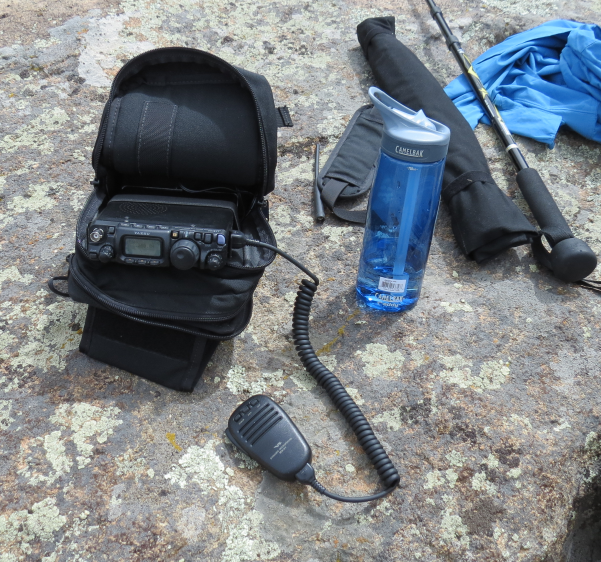 The above photo shows the FT-817 in its Sitting-On-A-Big-Rock operating position, using the AMP-3 carrying case with lead-acid battery inside.
The above photo shows the FT-817 in its Sitting-On-A-Big-Rock operating position, using the AMP-3 carrying case with lead-acid battery inside.
I had arranged a sked with Stu W0STU who was located ~100 miles away with a group of Scouts at Peaceful Valley Scout Ranch. There wasn’t a solid radio path between our two locations, so I wasn’t sure if we’d make it or not. I did not think we could make the contact on FM but the efficiency of SSB should do better. He had a small yagi pointed in my direction driven by an FT-857 transceiver but we tried working on 144.200 MHz SSB without any success. Another station W6LEV near Loveland came up on the calling frequency so I worked him.
After working a few stations on 146.52 MHz using a half-wave whip on the FT-60, I decided to try to work W0STU one more time. I sent him a text message and confirmed that he was available. However, snow was moving into his location (welcome to spring) so he had dismantled his yagi antenna and only had a vertical antenna on his truck. I told him to give me a call on 144.200 SSB and I’d try to find him. I flipped my yagi to vertical polarization and pointed in his direction.
At first, I heard nothing but noise. I was about to give up when I rotated my antenna around to see if the signal peaked up in another direction. Sure enough, when pointed S/SW, I could hear Stu’s signal rise to just above my noise floor. His actual direction from me was SE, so we were probably getting a reflection off one of the mountains to the south. My signal was right at his noise floor, so we just barely completed a contact. Without the weak-signal performance of SSB and the gain of the yagi antenna, I am sure we would have never completed the contact. Another lesson is that it pays to point your antenna in different directions, since you don’t always know what the best propagation path will be.
Another fun day messing around with ham radio.
73, Bob K0NR
